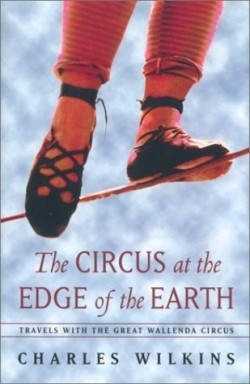The Circus at the Edge of the Earth
Travels with the Great Wallenda Circus
Mired in a creative rut in the spring of 1997, Wilkins—whose previous works include After the Applause with hockey icon Gordie Howe—indulged a childhood fantasy and ran off with the circus. “I craved a little risk and excitement, needed to do something different,” he explains. But, like any writer, he also was searching for a compelling story. For both needs, accompanying the Great Wallenda Circus on its month-long Canadian tour was a master stroke of genius.
Wilkins takes on something of a ringmaster’s role as he introduces the reader to a group of performers whose stunning talents are matched only by the stoicism with which they face the risk of death or crippling injury every time they mount the high wire or enter the cage with eight snarling tigers. He recounts in equally compelling detail their most horrific moments—particularly the 1962 collapse of the Wallendas’ human pyramid during a performance in Detroit, which killed two aerialists and paralyzed another—and the everyday struggles of assembling a circus and moving it from city to city, a process beset by a seeming conspiracy of bad weather, red tape, malevolent competitors and mechanical breakdowns.
Wilkins is at his best when profiling such colorful characters as circus owner Ricky Wallenda, himself in constant pain from a high-wire tumble that broke his back, and tiger trainer Wilson Barnes, who considers himself lucky to have experienced nothing worse than a vicious bite that ground part of his leg into hamburger. Then there’s Bobby Gibbs, 370-pound trainer of Gentle Judy the elephant. Grouchy and humorous, profane and devout, Gibbs becomes Wilkins’ companion and guru, imparting the wisdom and experience of his fifty years in the circus biz. “Think of it as a textbook,” Gibbs tells his pupil —a book that, he warns, might soon be out of print because of a variety of pressures, including activists’ campaign to ban live animal performances. “What you’re seeing is the end of the circus as we know it.”
Regardless of one’s position on that contentious issue, the reader will find the story so engrossing that its rather abrupt conclusion arrives all too quickly. This is a vivid portrait of an American cultural treasure, one sure to inspire hopes that, somehow, the show will always go on.
Reviewed by
John Flesher
Disclosure: This article is not an endorsement, but a review. The publisher of this book provided free copies of the book to have their book reviewed by a professional reviewer. No fee was paid by the publisher for this review. Foreword Reviews only recommends books that we love. Foreword Magazine, Inc. is disclosing this in accordance with the Federal Trade Commission’s 16 CFR, Part 255.

